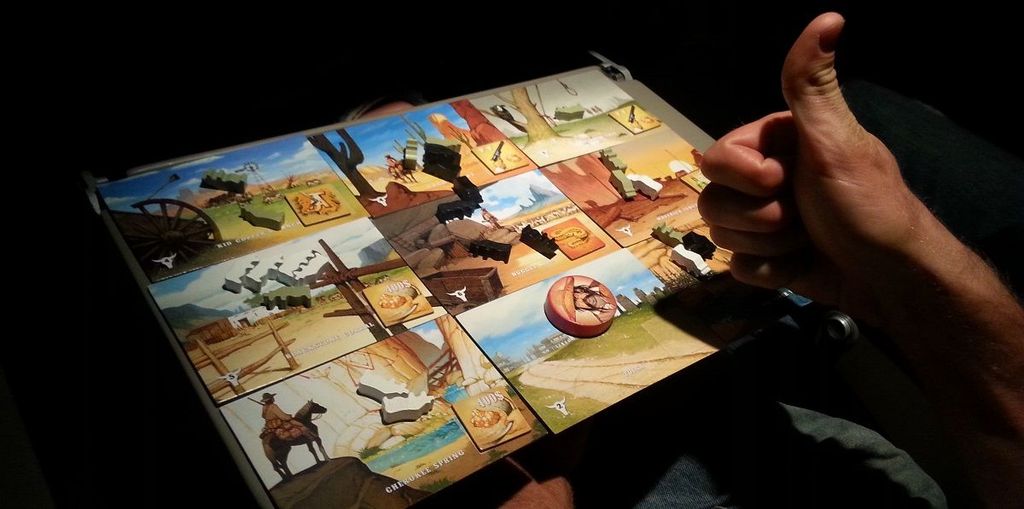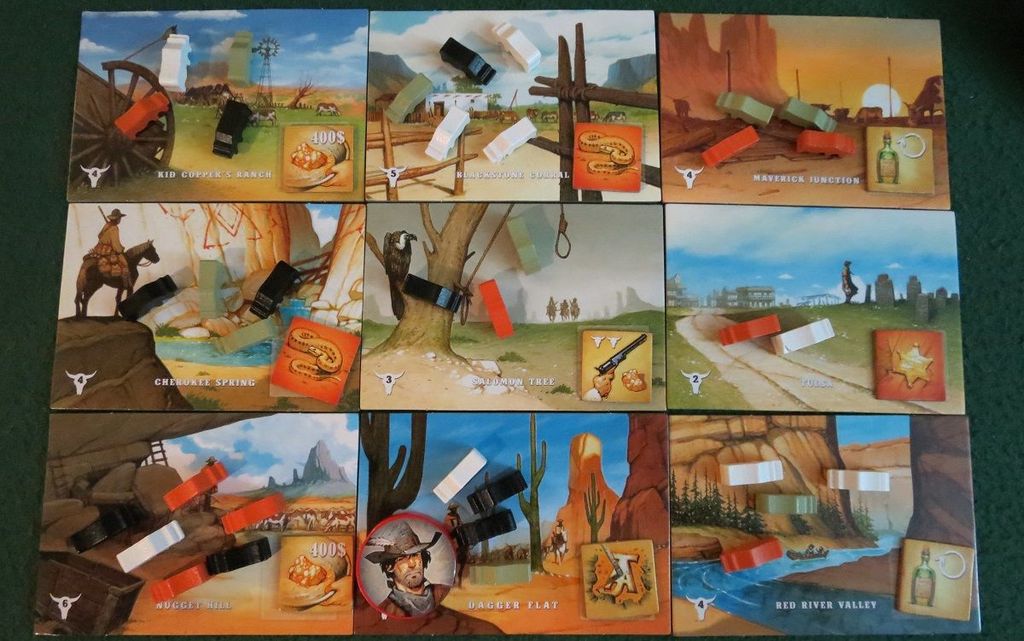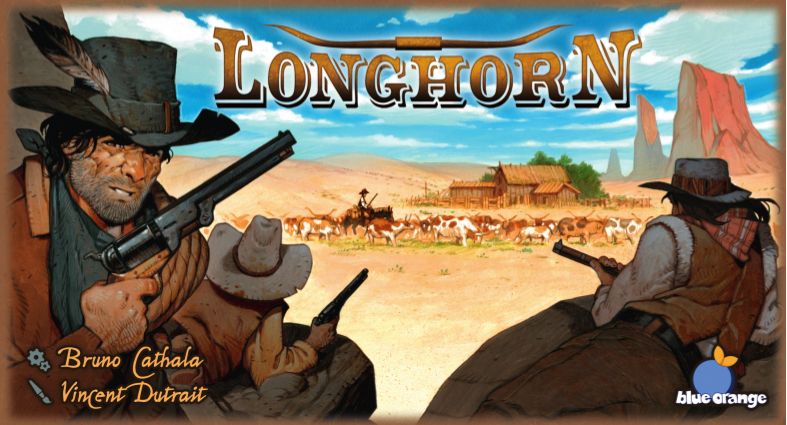Hey there, fellow board game enthusiasts! Today, we’re diving into a review of a game that has quickly become a favorite on my game nights – Longhorn. Stick around as I chat about the mechanics, the gorgeous artwork, and how much fun (or frustration) you might have with your buddies while playing this gem. Let’s see if Longhorn is worth adding to your collection or if it belongs back on the shelf!
How It Plays
Setting Up
First, mix up the nine location tiles and place them in a 3×3 grid. Randomly place four cattle tokens on each tile. Each player chooses a character pawn, and places it on a random location tile. Don’t forget to place the draw bag of cattle tokens within easy reach!
Gameplay
On your turn, move your pawn to a different location tile. The number of cattle tokens on your current tile tells you how many steps you can move. Once you land, take all cattle tokens from that new tile. Then, place one of those cattle in the draw bag and follow the action dictated by that location tile. Rinse and repeat until there is no legal move left.
Winning the Game
The game ends when there are no legal moves or if a player is forced to land on an empty tile. Score points based on the number of cattle of each color. Specific actions, like stealing back cattle or making your opponent land on empty tiles, spice up this race to collect the most lucrative herd.
Want to know more? Read our extensive strategy guide for Longhorn.
Game Mechanics and Balance in Longhorn
One of the first things you’ll notice when playing Longhorn is how smooth the mechanics feel. This is not your typical game where you have to keep track of a hundred different things. Instead, it relies on a simple yet intriguing mechanic – moving the sheriff and collecting cows. The elegance of these mechanics makes the gameplay engaging and keeps the action flowing.
Balance is a tricky thing to nail down in board games. Too much luck, and it feels unfair. Too many rules, and it gets bogged down. Fortunately, Longhorn strikes a good balance. When I played it with my friends, we all had moments of triumph and despair, but it never felt like the game was out to get us. The mix of strategy and chance allows for smart plays without making the game feel rigged.
One aspect that struck me was how every move matters. Since you can only move the sheriff to where there are cattle, you have to think a couple of steps ahead. This means you need to plan without being able to predict everything – just like in life, right? But beware, the more cows you take, the scarcer the resources become. This adds a layer of tension and excitement, making each game different and challenging.
I do have a slight nitpick, though. Sometimes, the luck of the draw can sway the game a bit more than I’d like. But overall, it balances well with strategic thinking.
Next, I’ll talk about the game’s replay value. Spoiler: it’s surprisingly high!

Replay Value: Why Longhorn Keeps You Coming Back
I love finding a game that keeps me entertained session after session, and Longhorn delivers just that. The replay value in this game is fantastic. First off, the game boasts a modular board set-up. Every time you play, the layout changes. This keeps the game feeling fresh and unpredictable, which is a big plus.
The game’s various strategies are another factor that adds to its replayability. Depending on the board set-up and the actions of your opponent, you’ll need to rethink your strategy every time you play. Will you steal cows to limit your opponent’s options, or will you go for a gold rush? The choice is yours, and it changes with every game.
Another feature that boosts replay value is the game’s length. Longhorn is quick to play, clocking in at around 15-20 minutes. This short playtime means you can easily fit multiple games into an evening, allowing you to experiment with different tactics and strategies in a short amount of time.
Playing against different opponents also adds to the fun. Some players are aggressive, while others play more defensively. You’ll never know what to expect, which keeps you on your toes and makes every game a unique experience.
Lastly, the game’s balanced mechanics ensure that no single strategy is overpowered. This makes sure the games stay fair and fun, increasing the game’s longevity on your shelf.
Now, let’s saddle up and mosey on over to the next part of our review: the artwork and components.

Artwork and Components in Longhorn
First things first, Longhorn brings you right into the wild west. The artwork is simply stunning, almost like a time machine back to the cowboy era. I mean, when you glance at the game board, you can nearly smell the dust and hear the cattle mooing.
The game’s components are top-notch too. The cattle tokens are crafted from thick cardboard, which gives a weighty feel. No flimsy pieces here! And those player pawns? They are chunky, wooden, and really fun to move around. My friend Jason spent an entire round just admiring how well the pieces fit into the game theme. You gotta love it when a game makes you want to play cowboy for real!
The cards also deserve a special mention. The illustrations are vivid with a rustic charm that brings each character to life. I swear, there’s one card that looks exactly like my uncle Bob. It’s uncanny and it adds to the overall amusement.
However, I did spot one minor drawback. The game box is a bit on the small side. While it’s perfect for travel, you might have to do a little fiddling to fit everything back inside after playing. Sure, it’s a minor gripe, but worth noting for the neat freaks out there.
Overall, Longhorn nails it with artwork and components. If you’re a sucker for thematic immersion, this game ticks all the right boxes. And, let’s be honest, who doesn’t want to feel like a bandit at least once?
Ready to hear about how you’ll be interacting with your fellow outlaws? Hold onto your cowboy hat, because next, we tackle player interaction!
Player Interaction in Longhorn: Strategy and Fun
If you’re looking for a game that keeps you and your opponent on your toes, Longhorn delivers. This game is all about reading your opponent’s next move, and it can feel a bit like playing chess with cows and gold nuggets. You’ll spend a lot of time trying to outthink, outmaneuver, and sometimes downright outsmart your opponent.
One of my favorite moments while playing Longhorn is the delicious tension when you’re forced to leave a juicy opportunity for your opponent. Maybe you don’t want to leave them a tile rich with cows, but you also can’t stand the thought of them snagging that sweet gold nugget. The back-and-forth here is delightful and keeps everyone engaged from start to finish.
But it’s not all strategy. There’s also a healthy dose of sabotage and mischief, which feels quite fitting for a Wild West-themed game. Swapping tiles or stealing cows isn’t just satisfying; it’s hilarious when it happens at the perfect moment. Picture your friend gloating over their herd—then you swoop in and leave them with nothing but dust. It’s moments like these that make Longhorn so memorable.
However, the game isn’t all roses. Sometimes, the luck of the draw can tilt the scales unfairly. But hey, it’s the Wild West—where anything can happen.
Overall, I absolutely recommend Longhorn. It’s strategic, interactive, and, most importantly, a ton of fun. So round up your herd and get ready for a showdown!
Conclusion
Longhorn offers a delightful blend of strategy and luck in a compact, engaging package. The game’s mechanics are smooth and balanced, with just the right dash of unpredictability to keep things interesting. Its modular board and varied strategies ensure high replay value. The artwork and components are charming, with a minor gripe about the quality of some pieces. Player interaction is dynamic, adding a competitive edge to every session.
Overall, Longhorn is well worth adding to your collection if you enjoy games that are easy to learn but hard to master. This concludes our review. Now, go rustle up some cattle and outsmart your opponent!


